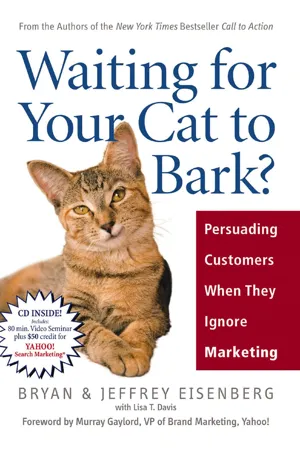
Waiting for Your Cat to Bark?
Persuading Customers When They Ignore Marketing
- 240 pages
- English
- ePUB (mobile friendly)
- Available on iOS & Android
Waiting for Your Cat to Bark?
Persuading Customers When They Ignore Marketing
About this book
Evolving from the premise that customers have always behaved more like cats than Pavlov's dogs, Waiting for Your Cat to Bark? examines how emerging media have undermined the effectiveness of prevailing mass marketing models. At the same time, emerging media have created an unprecedented opportunity for businesses to redefine how they communicate with customers by leveraging the power of increasingly interconnected media channels.
Bryan and Jeffrey Eisenberg don't simply explain this shift in paradigm; Waiting for Your Cat to Bark? introduces Persuasion Architecture™ as the synthetic model that provides business with a proven context for rethinking customers and retooling marketers in a rewired market.
Readers will learn:
- Why many marketers are unprepared for today's increasingly fragmented, in-control, always-on audience that makes pin-point relevance mandatory
- How interactivity has changed the nature of marketing by extending its reach into the world of sales, design, merchandizing, and customer relations
- How Persuasion Architecture™ allows businesses to create powerful, multi-channel persuasive systems that anticipate customer needs
- How Persuasion Architecture™ allows businesses to measure and optimize the return on investment for every discreet piece of that persuasive system
"There's some big thinking going on here-thinking you will need if you want to take your work to the next level. 'Typical, not average' is just one of the ideas inside that will change the way you think about marketing." ?Seth Godin, Author, All Marketers Are Liars
"Are your clients coming to you armed with more product information than you or your sales team know? You need to read Waiting for Your Cat to Bark? to learn how people are buying in the post-Internet age so you can learn how to sell to them." ?Tom Hopkins, Master Sales Trainer and Author, How to Master the Art of Selling
"These guys really 'get it.' In a world of know-it-all marketing hypesters, these guys realize that it takes work to persuade people who aren't listening. They've connected a lot of the pieces that we all already know-plus a lot that we don't. It's a rare approach that recognizes that the customer is in charge and must be encouraged and engaged on his/her own terms, not the sellers. Waiting for Your Cat to Bark? takes apart the persuasion process, breaks down the steps and gives practical ways to tailor your approaches to your varying real customers in the real world. This book is at a high level that marketers better hope their competitors will be too lazy to implement." ?George Silverman, Author, The Secrets of Word of Mouth Marketing: How to Trigger Exponential Sales Through Runaway Word of Mouth
"We often hear that the current marketing model is broken-meaning the changes in customers, media, distribution, and even the flatness of the world make current practices no longer relevant. Yet few have offered a solution. This book recognizes the new reality in which we operate and provides a path for moving forward. The authors do an outstanding job of using metaphors to help make Persuasion Architecture clear and real-life examples to make it come alive. Finally, someone has offered direction for how to market in this new era where the customer is in control." ?David J. Reibstein, William Stewart Woodside Professor, Wharton Business School of the University of Pennsylvania and former Executive Director, Marketing Science Institute
"If you want to learn persistence, get a cat. If you want to learn marketing, get this book. It's purrfect." ?Jeffrey Gitomer, Author, The Little Red Book of Selling
Frequently asked questions
- Essential is ideal for learners and professionals who enjoy exploring a wide range of subjects. Access the Essential Library with 800,000+ trusted titles and best-sellers across business, personal growth, and the humanities. Includes unlimited reading time and Standard Read Aloud voice.
- Complete: Perfect for advanced learners and researchers needing full, unrestricted access. Unlock 1.4M+ books across hundreds of subjects, including academic and specialized titles. The Complete Plan also includes advanced features like Premium Read Aloud and Research Assistant.
Please note we cannot support devices running on iOS 13 and Android 7 or earlier. Learn more about using the app.
Information
CHAPTER ONE:
Dogs, Cats,
and Marketing
Cooking up a conditioned response
Far-reaching implications
“Tom” foolery
Cat Haiku
Is old, and more to the point
Contains no tuna.
Ignored. The more difficult
Ones can be slept through.
You seem to have it backwards:
This pillow’s taken.10
Consumer branding: calling all cats
Table of contents
- Cover Page
- Title Page
- Copyright Page
- Dedication
- Contents
- Foreword: Murray Gaylord, Yahoo! Inc.
- Introduction
- Chapter One: Dogs, Cats, and Marketing
- Chapter Two: Experiencing the Brand
- Chapter Three: Friction and Customer Experience
- Chapter Four: Why Marketing Is Simple But Hard
- Chapter Five: Marketers Out of Control
- Chapter Six: Customers in Control
- Chapter Seven: How Customers Buy
- Chapter Eight: Maintaining Persuasive Momentum
- Chapter Nine: Marketing and Sales Collide
- Chapter Ten: The Design of Persuasive Systems
- Chapter Eleven: A Web of Interactivity
- Chapter Twelve: Brands Cross Channels
- Chapter Thirteen: Insights and Customer Data
- Chapter Fourteen: Personalization or “Personalization”
- Chapter Fifteen: Introducing Personas
- Chapter Sixteen: Uncovering the Knowable
- Chapter Seventeen: Disclosing the Necessary
- Chapter Eighteen: Mapping Business Topology
- Chapter Nineteen: The Topology of a Sale
- Chapter Twenty: The Human Operating System
- Chapter Twenty-One: Choosing Personas
- Chapter Twenty-Two: Bringing Personas to Life
- Chapter Twenty-Three: The Architecture Metaphor
- Chapter Twenty-Four: Wireframing As an Interactivity Map
- Chapter Twenty-Five: Architecting a Persuasion Scenario
- Chapter Twenty-Six: Storyboarding and Prototyping the Scenarios
- Chapter Twenty-Seven: Accountable Marketing
- Chapter Twenty-Eight: Persuasion Architecture: A Six-Step Process
- Chapter Twenty-Nine: Celebrating Your Cats’Meows
- Notes